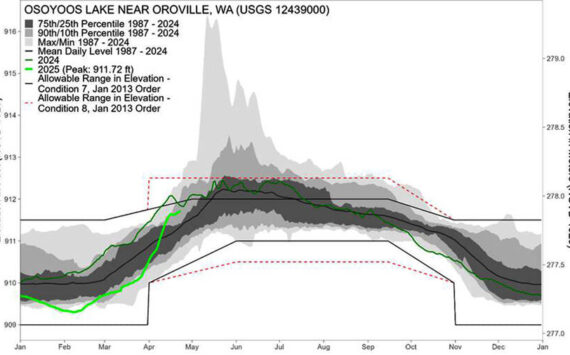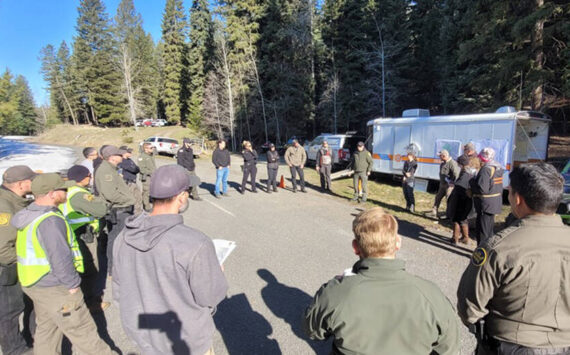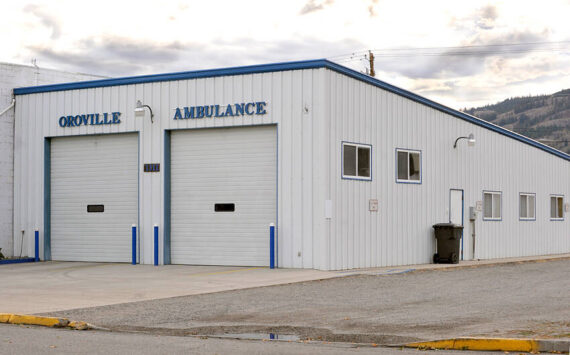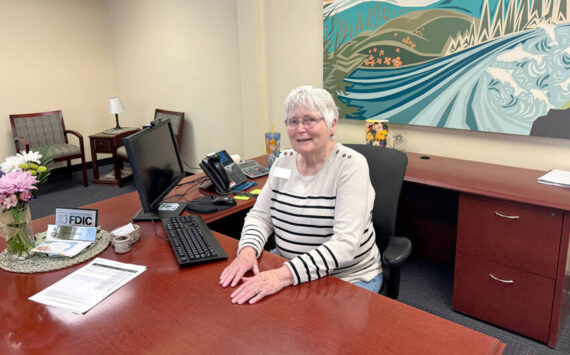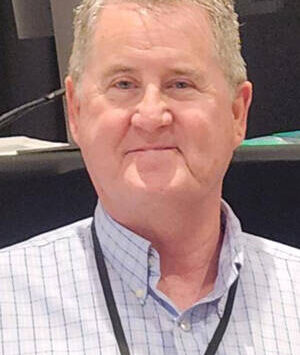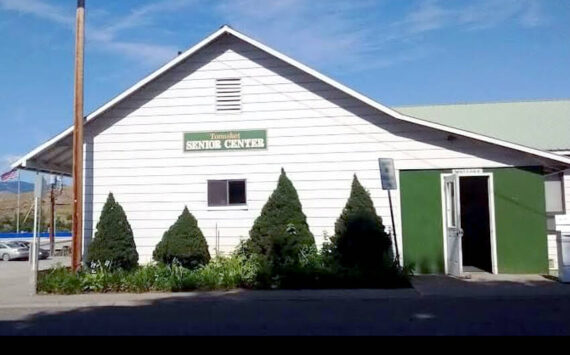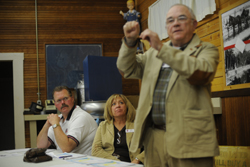
Okanogan County PUD Commissioner Ernie Bolz (standing) answers a question from the audience at a special meeting of the PUD Commissioners held at the Oroville Depot. Bolz and his fellow commissioners, David Womach and Trish Butler, as well as District Man
OROVILLE – TheOkanogan County Public Utility District has been having a series of publicmeetings to explain why it will soon be asking for its first raise inelectrical rates in nearly ten years.
The last increasewas in 2001 according to John Grubich, General Manager for the PUD. Grubich andthe three commissioners on the PUD board, as well as other utility staff metwith ratepayers in a public meeting held at the Oroville Depot last week todiscuss the proposed cost increase.
Grubich said severalthings had changed since 2001 and explained the cost of purchased power hadrisen almost 64 percent since 2001 while the PUD had held the rates at theircurrent level. He also showed those in attendance a graph illustrating how thecosts of most products had risen, including everyday items like food which hadgone up anywhere from 14 percent for milk to 78 percent for eggs, whilegasoline had increased by 82 percent.
Grubich said ifthe district does not increase their rates this year it will go $2.5 million inthe red and the district would not be in compliance with it’s debt serviceratio.
In 2001 thedistrict became a SLICE customer and took on some of the risk associated withthe flow of the Columbia River, which also allowed the district to sell theextra energy, according to the PUD manager. Between 2006 and 2008 the districthad a windfall of between $8 million and $10 million a year in energy sales.However, in 2009 the decrease in precipitation and low water, as well as theeconomy turning down, found that people were buying less electricity, Grubichsaid.
“We had been ableto maintain the rate since 2001 through good sales of power and offsets,” hesaid.
The market forthe PUD’s extra power is not expected to bethere at least in the near future and the way the Bonneville PowerAdministration supplies power is changing.
“The federal hydro system is fully allocated, there will be no surplusafter 2010. Bonneville will draw a line in the sand and tell Okanogan CountyPUD that’s what your getting… it’s three cents a kilowatt hour today, the nextcosts could be between seven and ten cents a kilowatt hour,” Grubich said.
 Okanogan County PUD, like mostpublic electric utilities in counties on the eastern side of the state haveeither already started to raise rates or are planning on doing so, according tothe district’s general manager.
Some of the costs the PUD has incurred include building a newheadquarters building at Okanogan. Grubich said the reason for the new buildingwas that the district had outgrown the old one and that the infrastructure ofthe 55 year-old building – plumbing a d heating, was getting too hard to fixand that parts were no longer available. Because of the lack of room staff wereusing two trailers set up in the parking lot for office space.
“The reason we chose to build now is because in the good years westarted a building fund,” he said. “It also helps the local economy, createsjobs and with the economy the way it is now building we will save 20 percentover what it would have cost just two years ago. The new headquarters will havesafer, easier access and improved parking.”
The new building will also have an improved public meeting facility forup to 150 people.
Other costs include a new transmission line to serve both OkanoganCounty PUD customers and Methow Valley Electrical Co-op customers in the MethowValley. Grubich said the BPA is paying for two-thirds of the costs ofconstruction of the line.
“It saves eight million kilowatt hours a year in line loss, that’sabout $400,000 a year in energy savings,” Grubich said.
The Pateros to Twisp transmission line has been controversial and thedistrict has been fighting legal battles with those who believe the old transmissionline should have been rebuilt instead. These battles have added several hundredthousands of dollars to the project’s overall costs. At least two of those atthe meeting got in a heated discussion voicing their opposition to the newtransmission line.
The district manager said rehabilitating Enloe Dam on the SimilkameenRiver near Oroville will also improve the district’s ability to reliablydeliver electric power.
When asked what impact it would have on the district’s bottom line ifit didn’t develop the dam, Grubich said the cost of Enloe represented abouttwo-tenths of one percent if they didn’t do it.
Comparing costs Grubich said Enloe could generate electricity atbetween six and seven cents a kilowatt hour (kwh) about the same as a gas turbine.Nuclear energy is about 10 cents a kilowatt hour, wind is between ten and 12cents and solar is 25 cents a kwh, he said.
“Enloe would take care of the load increase in Okanogan County,” saidthe manager.
The district is proposing a rate increase divided over the next threeyears. District staff prepared and presented comparisons of the bill impactsfor three different size homes after increases this year and in 2011 and 2012.For the smaller home with an average monthly use of 1497 kwh over the year, therate would increase about $2.41 a month in 2010 over 2009, $9.92 a month in2011 over 2009 and $17.81 a month in 2012 over 2009. For a larger home with anaverage monthly use of 2126 the increase over 2009 in 2010 would be $7.73 amonth; $16.32 in 2011 and $27.50 in 2012. For the largest home in thepresentation, one using 2599 kwh per month, there would be $14.53 in 2010 overthe 2009 bill; $24.11 in 2011 and $38.79 in 2012.
The new rate plan would be two tiered, much like people’s water billsin Oroville. Residential
customers would have a $10 a month basic charge  and rate for the first 2000 kwh. A higherrate would be charged for 2000 kwh of use and above to encourage conservation.The basic charge would spread the fixed costs of the PUD’s system over allcustomers, even those who might not live in their homes for several months ofthe year. Grubich said these fixed infrastructure costs remain whether the homeis occupied or not.
Commercial and industrial ratepayers would also see their rates change,in some cases for the better as Grubich says certain commercial ratepayers havebeen helping to subsidize residential ratepayers and the new rates are designedto be more fair to all customers. As a public utility, the district is notallowed to operate at a profit.
Even with the new rate hikes Grubich said the district would have thefifth-lowest electrical rates in the state and perhaps the nation. He said rateincrease decisions being discussed in other PUDs might even put Okanogan CountyPUD in the fourth-lowest position.
To see how the new rate changes would affect their bills customers cango to the district’s Web site http://www.okanoganpud.org,click on electric and chose rates and policies from the drop down menu and usetheir rate calculator.
Grubich, staff and PUD Commissioners Ernie Bolz, David Womach and Trish Butler, were on hand to try and answer questions about the rate increases.
